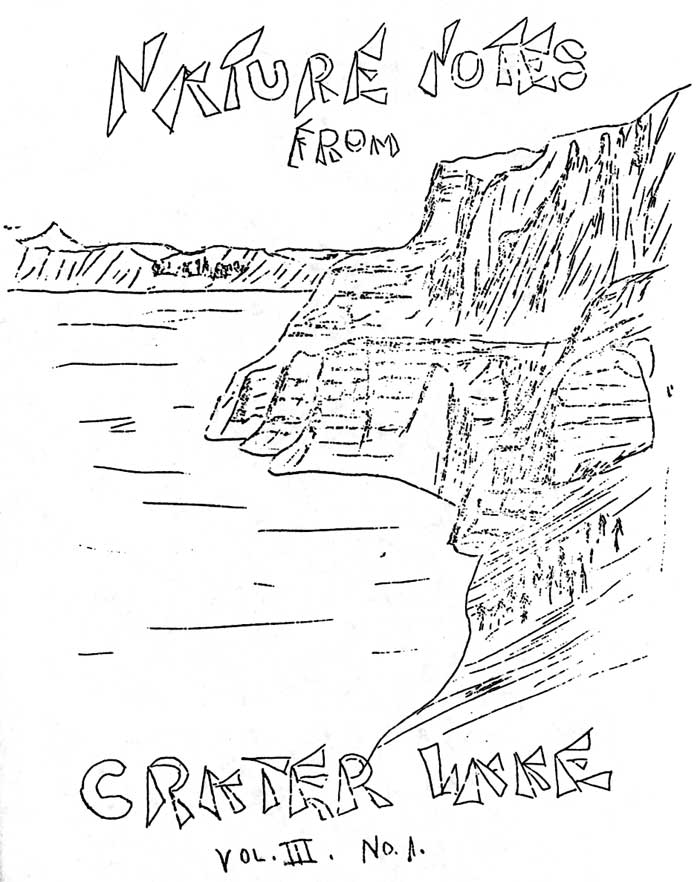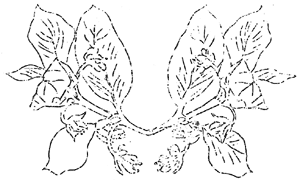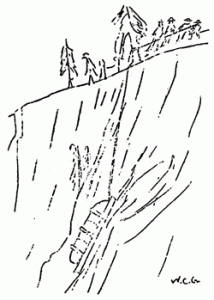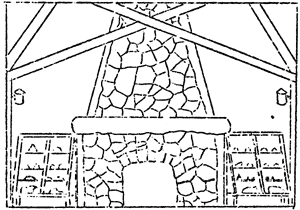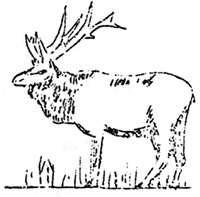
Volume 2 No. 2 – August 1, 1929All material courtesy of the National Park Service. These publications can also be found at http://npshistory.com/Nature Notes is produced by the National Park Service. © 1928. |
Castle Crest Garden
By Earl U. Homuth
That the variety and profusion of wild flowers in Crater Lake National Park compares favorably with those of other Parks, is not generally evident to the casual visitor. The limited flora found on the immediate Rim where most visitors camp may have given this impression. But the moist meadows and swamps, where the streams are block by moraines, and the slopes where countless springs flow from the rocks provide conditions in which typical mountain wild flower gardens are found.
A natural wild flower garden of this type lies at the base of Castle Crest, less than two miles from the Rim and a few hundred yards from Headquarters, hidden from the road by a series of moraines. A path has been constructed to this garden. It passes through a variety of habitats, including talus slopes, dry pumice slopes, moist cliffs, forest and swamps. The elevation of 6600 feet places it on the border between the Canadian and Hudsonian Zones, so that the forest trees seen on the Rim above, and those of the lower slopes of Mount Mazama are represented.
Among the wild flowers over two hundred species have been listed, including four species of mimulus, or Monkey flowers, of which the Pink Monkey flower (Mimulus lewisii) grows in great masses of color. The Monk’s hood (Aconitum columbianum),Senecio (Senecio triangularis), and Fleabane (Erigeron salsuginosus) occur in particular abundance in the moist areas, while the moraines are covered with great patches of Scarlet Gilia (Gilia aggregata) and a veritable hedge of lupines, sedges and numerous others form a boundary between the moist and dry habitats. Countless mosses occur on knolls built up on the meadow. The forest floor is covered with creeping currants and raspberries. Near the entrance to the garden is the largest area of Western Anemone(Pulsatilla occidentalis) to be found in the vicinity. Two species of orchids (Limnorchis stricta and L. dilitata) are also to be found.
Species not occurring now will be transplanted and it is hoped that Castle Crest Garden which has been named for the towering cliff which rises two thousand feet above, may in time become recognized as a distinct feature of Crater Lake National Park.
Fantastic Carvings By Erosive Agents
By Dale Leslie, Ranger Naturalist
The various agents of erosion have carved many fantastic images on the massive igneous outcrops found on the rim of Crater Lake.
As one views the profile of Garfield Cliffs from the west, he sees a huge boulder jutting from the wall about half way to the summit of the escarpment. This mass of rock from this position assumes the shape of a bear partly emerged from its den. So vividly is this portrayed, one imagines the head and shoulders are undergoing physical strain endeavoring to drag the rest of the body from the den.
How long this masterpiece of nature may be seen is not known as the walls of the cliff are rapidly wearing away as evidence in the small daily rock slides which occur in that area.
However, if the image of the bear is gradually being effaced, it may be possible for another still more fantastic shape to be formed at some point further down from the debris which falls from above.
The Cleetwood Rudder
By Earl U. Homuth
Among the many interesting relics in the possession of William G. Steel, which will be presented to Crater Lake National Park when a permanent museum is established, is the rudder of the Cleetwood, the boat used in sounding the Lake in 1886.
When the Geological Survey complied with a request for a survey of Crater lake in that year, Mr. Steel was commissioned to build a large boat and two skiffs. The boats were brought to Ashland from Portland on a railroad flat-car. There a heavy sling of canvas and ropes was fixed to a wagon frame, and the boat carried in this sling to ease the jolts and strains of a rough journey through the mountains to Crater Lake. A week was required for the trip. The route followed the old road which crosses the Cascade Divide about six miles south of the Lake. It was necessary to spend a full day for the last stage of the jaunt, going directly up the slopes of the mountain through the forest, across snow-fields, logs and finally to the Rim.
A crate of heavy timber was then constructed, the boat lashed to the crate, and a stout cable snubbed around a tree on the Rim. This tree still stands as a landmark of this unusual launching.
The boat was pushed over the edge of the Rim, and the line played out as it slid toward the bottom. The slope here is approximately at an angle of 45 ° and the Rim lies about 950 feet above the water. Sixteen men accompanied the boat down to the lake.
When half way down, the boat was secured, while the rope was snubbed around a tree at that point. When the line was again entirely played out the boat was still more than ten feet from the water, with the prow projecting several feet over a ledge about ten feet high. The boat could not be pulled back nor could more rope be spliced in. The only alternative was to cut the rope and allow the boat to drop into the water. It was necessary that someone should accompany the boat to bring it back to shore should it ride too far out. Everyone in the party volunteered. The boy who had driven the team on the trip from Ashland was chosen, it being reasoned that since he was the only person to have ever come by boat to Crater Lake he should be the one to finish the trip.
The boy braced himself to the stern. With one stroke of the axe the rope was cut. The boat shot forward over the ledge, dropped upright on the water, and floated safely upon the Lake. The lad gathered himself up in the bow, bruised and bloody, but the happiest boy in Oregon for having completed this strange boat ride.
Later an unofficial sounding of the Lake, a few hundred feet from land was made. Great depths were anticipated, each man venturing a guess. The line was gradually let down. As it sank deeper and deeper the men watched with increasing astonishment. Six hundred, eight hundred, one thousand feet — and still it continued to sink! When the line finally stopped at 1210 feet, the men gave vent to their amazement in a shout which brought those on the Rim hurriedly down the slope fearing someone had been killed.
Though it was late in the evening, a man was dispatched to Fort Klamath to give the news to the world that a depth of 1210 feet had been found near the shore of Crater Lake.
During the following days, soundings were made systematically the results of which are recorded on the maps used today. The greatest depth, 1996 feet, established Crater Lake as the deepest fresh water lake in the world other than Lake Baikal in eastern Russia.
As told by William G. Steel
to Earl U. Homuth
Conies
By Charlie Croghan, Ranger
In spite of the fact that conies are usually very timid and seclusive animals, this season they are becoming somewhat accustomed to the nearness of visitors at Crater Lake.
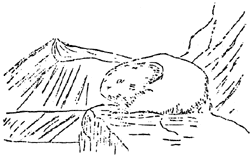
They may be seen busily engaged in carrying and storing their winter supply of forage at the foot of the new trail during the quieter moments between launch trips, giving observing passers-by a rare opportunity to study them. These exceedingly interesting little animals do not hibernate in the winter as do ground squirrels and marmots. Owing to the fact that their homes are deeply burried with snow seven or eight months of the year, they are busy during the short summer season laying up prodigious stores of grasses and other vegetation to be used as hay during the long winter. Among themselves they are very sociable, communicating with each other along the rocky pathways beneath the snow in the winter-time.
Notes on Three Amphibians
By Berry Campbell
At the foot of the new trail to the Lake, three species of amphibians were found on July 1, 1929. The first was the Longtoed Salamander, Ambystoma macrodactylum. This is a chocolate colored lizard-like animal, about four inches long, with a bright wheat stripe down its back from its neck to the tip of its tail. On its head are several more blotches of wheat. The adults are abundant under the rocks at the shore of the Lake, while in the small bays and pools, the larvae may be seen swimming about.
The Pacific Water Dog was also found. All of those seen were just losing their gills and metamorphosing into adult salamanders and, consequently, they were not as large as one would ordinarily find them. Those measured three and one-half or four inches but they grow to be twice that long. They may be recognized by their light orange stomachs and by their rough skin. The Water Dog is found along the whole Pacific Coast from Southern California to British Columbia.
The third amphibian was the Northwestern toad, Pufo boreas boreas. The specimen that we found was a young one, about two inches long; the ordinary length is about four or five inches. These toads may be recognized at once by the warts on their skin and the white stripe down their backs. They are found all over northwestern United States.
Poison!
By F. Lyle Wynd
The False Green Hellebore (Veratrum viride Ait.) is blooming in profusion on the camp ground at the Rim. Its large green leaves cause tourists to frequently mistake it for skunk cabbage.
The Hellebores have long been know to be very poisonous. All parts of the plant are lethal. As far back as the time of Pliny the deadly properties of this genus of plants were know. Pliny himself tells us how oxen, horses, and swine were killed by eating the foliage. On our own Pacific Coast, far from the time and place of Pliny, there is considerable loss among foraging stock when the grazing is short. The fine green leaves are very tempting to animals, although it is rare that they will eat them unless pressed by hunger.
The number of poisonous substances in the tissues of the Hellebores is very large indeed. Of these the so-called “veratrin” having the chemical formulae C32H19NO11, has a violent physiological effect. It causes severe sneezing and dilates the pupils of the eyes. Recently this substance has been reduced to several which were unknown to the earlier investigators. Of these the base, “cevadin”, is very toxic. “Veratridin” and “sabadillin” have also been separated from the “veratrin” of the earlier writers. There have been many other poisonous bases, alkaloids, and glucosides found in these plants by toxicologists.
Most cased of poisoning from this plant are due to over doses of the drug made from them.
The Indians used this plant as an emitic.
Crater Lake Museum Notes
By Miss Mable Hibbard, Ranger Naturalist
We are happy to announce the receipt of several donations for the Natural History Library in the museum. As the Government makes no appropriation for the purchase of books for library use these expressions of generosity are very much appreciated.
The collection of rock specimens has been increased with materials from many of the interesting lava flows about the Lake.
Study skins of the Bushy-tailed Woodrat and both adult and immature marmot have been added to the mammal case.
The only reptile heretofore collected in the Park is the Mountain Garter Snake, found by Dr. Loye Miller in July, 1926. Sections of the skin cast of two others have now been brought in from Wizard Island, and the presence of a live garter snake has been reported recently by one of the workmen.
A collection of insects injurious to the forest trees of the Park is almost ready to install in the wall cases which now contain the most representative specimens of the region.
One of the most popular features of the museum is the cut wild flower exhibit which totals over one hundred twenty-five specimens. Here visitors can identify at close range the flowers which they have seen in the Park, whether along the roadside, trail or in the numerous meadows.
The daily visitors to the museum usually number over two hundred. This attendance is an encouraging indication of increasing interest in museum exhibits.
Elk
By Earl U. Homuth
The interest of tourists is always aroused by the animals of our National Parks. Elk are not native in the region of Crater Lake, but recently several herds have been reported from the east side along the Rim Road. During future years Elk may become a regular attraction to visitors.
A herd of these animals was brought to Oregon from Jackson Hole country of Wyoming, by the State Game Commission. They were kept for a time in a game farm, and later distributed to various parts of the state. About twelve head were placed in Klamath County, east of Crater Lake, in 1913. This small herd has increased and now numbers over two hundred which have spread throughout the Cascade Range in this vicinity.
Three separate herds are known to be roaming about the Crater Lake region, one near Mount McLoughlin and one near Red Blanket, toward the south, both being outside the Park area, although the latter is reported occasionally within the south boundary. The third group is found about the slopes of Scott Peak. This is the herd which has been observed this season.
Other pages in this section

